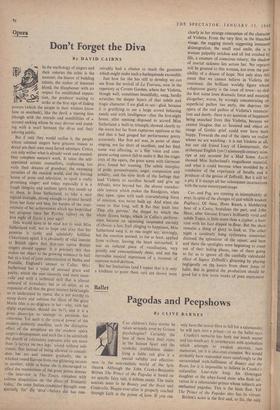Ballet
Pagodas and Peepshows
By CLIVE BARNES . only have the moral fibre to fall for a salamander, he will turn into a prince—or so the ballet says.
Cranko's scenario has both too much matter and too much art. It reverberates with symbolism which attempts to awaken atavistic race memories, yet it is also over-complex. We would probably have responded more satisfyingly to the unvarnished wish-fulfilment of Beauty and the Beast, for it is impossible to believe in Cranko*.; unfamiliar Lear-style king, his Gonregan daughter or the whey-faced sister who finds sal- vation in a salamander-prince whose subjects are enchanted pagodas. This is the basic flaw. Yet The Prince of the Pagodas also has its virtues.
Britten's score is the first and, so far, the only full-evening ballet score from a British com- poser. This music, modelled in part on the example of Tchaikovsky, is easy to follow at a first hearing. Its broad, readily distinguished themes, its bright orchestral colours, even its excursion into Balinese gamelan music, all add to its attractiveness. Beneath these surface charms are enduring qualities of structure and detail, and what at first sounds like agreeable triviality eventually takes on unsuspected sense. No British ballet has ever inspired a better score.
Right from the start Cranko's choreography is knocking its head against the stone wall of his story. Prevented from engaging our emotions dramatically, the ballet has to get at them visually by offering a dance design satisfying enough to compensate our imagination for the story's failure. Characters, dances, dance-images, dance-steps—all have to succeed in a vacuum. Every time the ballet has been revived, since its first performance three years ago, Cranko has titivated up the choreography. His latest polish- ing has again added to its general, but limited, impressiveness. There remains enough padding to fill a three-piece suite, but there is also enough inventive choreography to make, with the music, an exceptionally interesting, if non-dramatic, evening, especially when it is danced as trium- phantly as it was the other night.
The Paul Czinner film of the Royal Ballet in action has just been released in London. Designed to show Fonteyn in three contrasted roles, this pleasant peepshow contains a brief excerpt from Swan Lake, a nearly complete Firebird and most of Ondine. I'm glad to see the general rejoicing that has greeted this film, but I think two points need to be made clear. The first is that the film is not better than the ballets themselves at Covent Garden, whatever some people have suggested. Certainly some details—particularly in Ondine—emerge more vividly when picked out by Czinner's telephoto cyclops. Yet the shape of the choreography is often distorted and the per- sonalities of the dancers are largely lost.
Secondly, this is not properly a ballet film, and. indeed, it is hardly a film at all in the usual sense of the word. This is simply a filmed record of ballet, a completely adequate trailer to the real thing, and sometimes even a passable sub- stitute for it. The editing is an extremely clever piece of expertise. But don't let's have any non- sense about the result being high art.



































 Previous page
Previous page